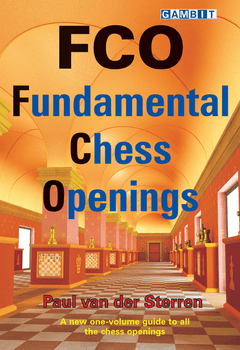| Nivå | B-C |
| Utgivelsesdato | Oktober 2009 |
| Forfatter | |
| Pris | 275 NOK |
Fundamental Chess Openings FCO
Et stort ettbinds verk om alle vesentlige sjakkåpninger, med verbale forklaringer av mange tidlige åpningstrekk som det sentrale. Her er det masse konkrete varianter, men få trekk framover. Det ser faktisk ikke ut til at en eneste trekkserie avsluttes med at dette er partiet "Karpov - Kasparov, Moskva 1985" eller tilsvarende henvisning til noe konkret parti.
Boka har først ca 190 sider åpninger som starter med 1 d4, deretter 70 sider med andre førstetrekk enn 1 e4 og 1 d4 (kalt Flank Openings) og til slutt 200 sider åpninger med 1 e4.
Vi antar at boka er mest aktuell for ambisiøse hobbyspillere og alminnelige klubbspillere med tilsammen ratingstyrke omlag 900 - 1800.
Forlagets egen omtale
- The perfect survival guide to the chess openings
- All openings covered
- Detailed verbal explanations of plans for both sides
- Up-to-date and featuring many tips and recommendations
- Insights into the 'character' of each opening
- Written by one of the world's foremost opening experts
The first moves of a chess game define the nature of the whole struggle, as both players stake their claim to the critical squares and start to develop their plans. It is essential to play purposefully and to avoid falling into traps or reaching a position that you don't understand.
This is not a book that provides masses of variations to memorize. Paul van der Sterren instead offers a wealth of ideas and explanation, together with the basic variations of each and every opening. This knowledge will equip players to succeed in the opening up to good club level, and provide a superb grounding in opening play on which to build a more sophisticated repertoire. The strategies he explains will, unlike ever-changing chess opening theory, remain valid as long as chess is played, and so the time spent studying this book will be rewarded many times over.
Introduction
In the colossal body of chess literature, no aspect of the game has been treated as extensively as the openings. In varying degrees of expertise, clarity and depth, thousands of books discuss every imaginable and unimaginable opening the game of chess has to offer. This is a process that will never stop. As long as a particular opening is being played, its variations will be worked out deeper and deeper and assessments will be modified on the basis of these new experiences. As long as chess is alive, its opening theory will also be alive and new books will be needed to document all of this new life.
This book intends to introduce the reader to this strange but fascinating world, the world of opening theory. There will be no long sequences of moves, no complicated analysis and no real attempt to keep up with the very latest developments. Instead I shall attempt to clarify the background, the genesis and the development of all major openings and try to show how they are much more interconnected and based on the same ideas and insights than many people think. This approach makes this book a very different one from the usual opening manuals. It could perhaps be said to precede them. If it has the effect on the reader that it whets his appetite for these 'usual' opening books, or at least makes him understand them a little bit better, this book will have fulfilled its purpose.
What is Opening Theory?
Everyone who devotes even the tiniest amount of thought to his first move not only makes a start with that particular game but also with the development of opening theory. From that moment on, every new game will confront him with the starting position again and therefore with his earlier thoughts on it. Also he will sooner or later find out that millions of other players have pondered exactly the same problems and, whether he wants to or not, he will to some extent start comparing his own ideas about how to start a game with theirs.
This means that opening theory arises quite naturally with the start of a game. No one can avoid it. It ends, equally naturally, with the end of a game. If we pursue our thinking about the opening position logically and systematically, while accepting only the highest possible degree of certainty as a satisfactory result, we cannot end our investigation unless we are sure we have reached either a winning or a drawn position. Seen in this light, thinking about the starting position involves a thorough examination of the middlegame and endgame as well.
It could be said then, that opening theory does not really exist, at least not as something separate from other aspects of the game. Ultimately, opening theory comprises all theory.
However, since the human brain and even the computer is still not capable of completely seeing through (and thereby destroying) chess as a whole, in practice opening theory does not end with an empty board but in positions where there is a certain consensus about how they should be assessed, for instance 'chances are equal' or 'White (or Black) has the advantage'.
Sometimes a question can be answered with total confidence. In the position after 1 e4 there is some room for discussion on how good or bad 1...g5 is (though not much), but if White continues 2 d4 here, there can be no question on the value of 2...f6 because 3 Qh5# is then mate. End of game, end of theory.
But in most cases an assessment is merely a temporary stop. The moment somebody starts questioning it, the argument continues. Until the next temporary stop is reached.
And so, ever since the beginnings of chess, every single chess-player has contributed something to that gigantic construction called opening theory. This brings us to the next question.
| Innbundet? | Nei |
| Type | Bok |
| Språk | Engelsk |
| Antall sider | 479 |

